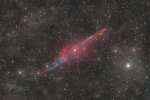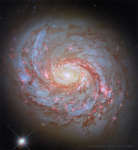
|
Astronomy Picture Of the Day (APOD)
 Apollo 17 at Shorty Crater
Apollo 17 at Shorty Crater
5.12.2025
Fifty three years ago, in December of 1972, Apollo 17 astronauts Eugene Cernan and Harrison Schmitt spent about 75 hours on the Moon exploring the Taurus-Littrow valley, while colleague Ronald Evans orbited overhead. This snapshot from another world was taken by Cernan as he and Schmitt roamed the lunar valley's floor.
 The Bipolar Jets of KX Andromedae
The Bipolar Jets of KX Andromedae
4.12.2025
Blasting outward from variable star KX Andromedae, these stunning bipolar jets are 19 light-years long. Recently discovered, they are revealed in unprecedented detail in this deep telescopic image centered on KX And and composed from over 692 hours of combined image data.
 Galaxies in the Furnace
Galaxies in the Furnace
3.12.2025
An example of violence on a cosmic scale, enormous elliptical galaxy NGC 1316 lies about 75 million light-years away toward Fornax, the southern constellation of the Furnace. Investigating the startling sight, astronomers suspect...
 APOD: 2025 December 3 B Visualization: Near a Black Hole and Disk
APOD: 2025 December 3 B Visualization: Near a Black Hole and Disk
2.12.2025
What would it look like to plunge into a monster black hole? This image from a supercomputer visualization shows the entire sky as seen from a simulated camera plunging toward a 4-million-solar-mass black hole, similar to the one at the center of our galaxy.
 APOD: 2025 December 2 B M77: Spiral Galaxy with an Active Center
APOD: 2025 December 2 B M77: Spiral Galaxy with an Active Center
1.12.2025
What's happening in the center of nearby spiral galaxy M77? The face-on galaxy lies a mere 47 million light-years away toward the constellation of the Sea Monster (Cetus). At that estimated distance, this gorgeous island universe is about 100 thousand light-years across.
 APOD: 2025 December 1 B 3I ATLAS: Tails of an Interstellar Comet
APOD: 2025 December 1 B 3I ATLAS: Tails of an Interstellar Comet
30.11.2025
How typical is our Solar System? Studying 3I/ATLAS, a comet just passing through, is providing clues. Confirmed previous interstellar visitors include an asteroid, a comet, a meteor, and a gas wind dominated by hydrogen and helium.
 APOD: 2025 November 30 B The Surface of Titan from Huygens
APOD: 2025 November 30 B The Surface of Titan from Huygens
29.11.2025
If you could stand on Titan -- what would you see? The featured color viewa from Titan gazes across an unfamiliar and distant landscape on Saturn's largest moon. The scene was recorded by ESA's Huygens probe in 2005 after a 2.5-hour descent through a thick atmosphere of nitrogen laced with methane.
 Moon Games
Moon Games
28.11.2025
This is not a screen from a video game. Nestled below the tree-line, the small mountain church does look like it might be hiding from Moon though. In the well-composed telephoto snapshot, taken on November 23, the church walls are partly reflecting light from terrestrial flood lights.
 NGC 6888: The Crescent Nebula
NGC 6888: The Crescent Nebula
27.11.2025
NGC 6888, also known as the Crescent Nebula, is a about 25 light-years across, a cosmic bubble blown by winds from its central, massive star. This deep telescopic image includes narrowband image data, to isolate light from hydrogen and oxygen atoms.
 Portrait of NGC 1055
Portrait of NGC 1055
26.11.2025
Big, beautiful spiral galaxy NGC 1055 is a dominant member of a small galaxy group a mere 60 million light-years away toward the aquatically intimidating constellation Cetus. Seen edge-on, the island universe spans over 100,000 light-years, a little larger than our own Milky Way galaxy.
|
January February March April May June July August September October November December |
|||||||||||||||||||||||||||||||||||||||||||||||||